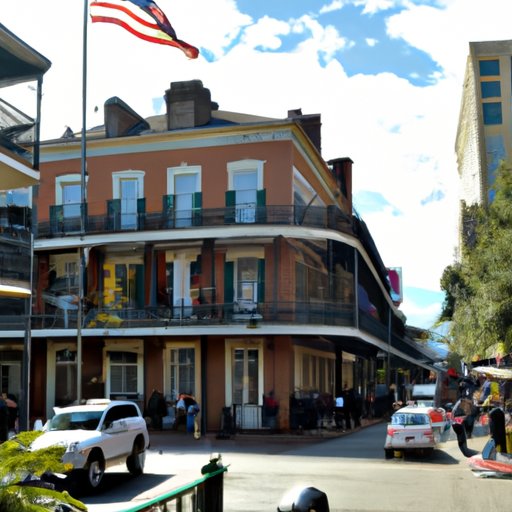Introduction
New Orleans, the largest city in Louisiana, has a rich cultural heritage that is unique to the Gulf region of the United States. Known for its vibrant music scene, eclectic cuisine, and world-famous Mardi Gras festival, New Orleans is a city that has something for everyone. In this article, we will explore the history, culture, and cuisine of New Orleans and provide recommendations for visitors looking to experience all that this city has to offer.
Discovering the Rich History and Cultural Significance of New Orleans, the Gem of Louisiana
New Orleans was founded in 1718 by the French explorer Jean-Baptiste Le Moyne de Bienville, making it one of the oldest cities in the United States. The city has a complex history that involves French and Spanish colonization, as well as African and Caribbean influences. Today, New Orleans is known for its contributions to the arts, including music, art, and literature. Famous musicians such as Louis Armstrong and Jelly Roll Morton got their starts in New Orleans, and the city has been an inspiration for writers and artists for generations.
However, New Orleans is not just famous for its art and music. Hurricane Katrina in 2005 had a devastating impact on the city, causing widespread flooding and extensive damage. The city has been working since then to rebuild and recover, and has made significant progress in recent years. Visitors to the city can witness the resilience and strength of the people of New Orleans, who have worked tirelessly to keep their vibrant culture alive.
From Jazz to Jambalaya: A Comprehensive Guide to Exploring the Unique Flavors of New Orleans
One of the best ways to experience the unique culture of New Orleans is through its cuisine. The city’s cuisine is influenced by a blend of African, French, Spanish, and Caribbean flavors. Visitors can sample dishes such as gumbo, jambalaya, and po’boys, as well as the famous beignets at the landmark Cafe du Monde. For a more upscale experience, Commander’s Palace and Emeril’s are both award-winning restaurants that offer a taste of the city’s luxurious side.
To truly immerse yourself in the city’s food scene, we recommend exploring the city’s diverse neighborhoods and trying out the local eateries. The Bywater, Mid-City, and Tremé neighborhoods are all home to unique culinary experiences that are not to be missed.
Haunted Histories and Mardi Gras Madness: Unveiling the Spooky Side of New Orleans
If you’re looking for a spooky side of New Orleans, there are plenty of options. The city is known for its haunted history, and visitors can take tours of the city’s cemeteries to learn about its ghostly past. Additionally, New Orleans is famous for its Mardi Gras celebration, one of the city’s most beloved events. The festival, which takes place in the weeks leading up to Lent, is known for its colorful parades, music, and parties. Visitors can see the parades, attend the various balls, and try traditional Mardi Gras foods such as king cake and fried chicken.
Walking in the Footsteps of the Greats: A Music Lover’s Guide to the Best Jazz Clubs in New Orleans
New Orleans is famous for its jazz heritage, and the city has a vibrant music scene that includes everything from traditional jazz to blues and funk. Recommended music festivals and events that showcase the city’s vibrant music scene. For those looking to experience the jazz scene firsthand, we recommend visiting clubs such as Preservation Hall and Tipitina’s, both of which have a long history of hosting famous musicians. The Spotted Cat Music Club and the Maple Leaf Bar are also both popular choices for live music.
Exploring the Eclectic Neighborhoods of New Orleans: A Journey Through the City’s Most Diverse Communities
New Orleans is a city of neighborhoods, each with its own unique character. The French Quarter is the most famous neighborhood, known for its historic architecture and vibrant nightlife. The Garden District is known for its grand mansions and beautiful parks, while the Lower Garden District is a trendy area with a thriving culinary scene. The Bywater and Tremé are two neighborhoods that are known for their vibrant music and arts scenes. Visitors can explore these neighborhoods on foot or by taking public transportation, such as the streetcar or bus.
From Plantations to Preservation: How New Orleans Preserves Its Cultural Heritage for Future Generations
Preserving the city’s unique architecture and landmarks is essential to the preservation of New Orleans’ cultural heritage. Many historic buildings were damaged or destroyed in the aftermath of Hurricane Katrina, but the city has worked to restore and preserve many of its landmarks, including the National World War II Museum. Visitors can also learn about preservation efforts at places such as the Preservation Resource Center and the Louisiana Landmarks Society.
Breaking Bread: A Foodie’s Guide to the Must-Try Dishes of New Orleans’ Renowned Restaurant Scene
For foodies, New Orleans is a culinary paradise. In addition to the famous dishes mentioned earlier, the city is home to a wide variety of restaurants and cafes, from traditional Creole and Cajun cuisine to international fare. Visitors can try “New Orleans-style” versions of dishes such as sushi, pizza, and tacos, or stick to classic dishes.
Conclusion
New Orleans truly is a city unlike any other. Its rich history, diverse cultural offerings, and unique cuisine make it a destination that visitors will never forget. We hope that this guide has provided helpful information for those looking to explore everything that New Orleans has to offer. So, grab some gumbo, put on some jazz, and get ready to experience the lively atmosphere of the gem of Louisiana.
